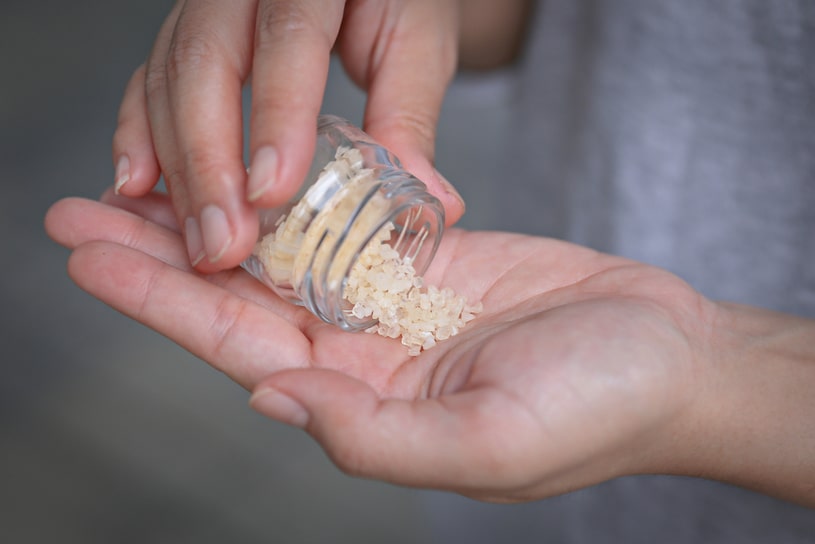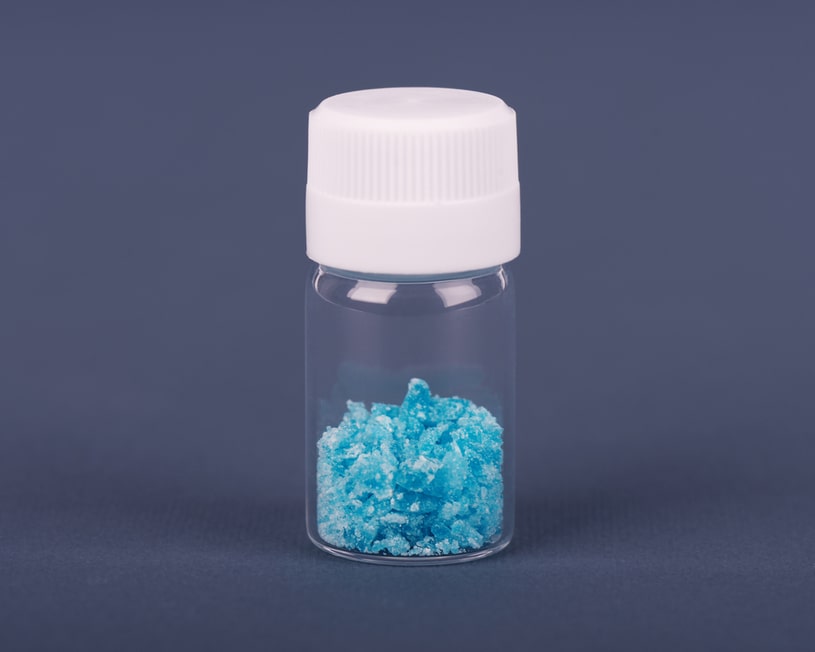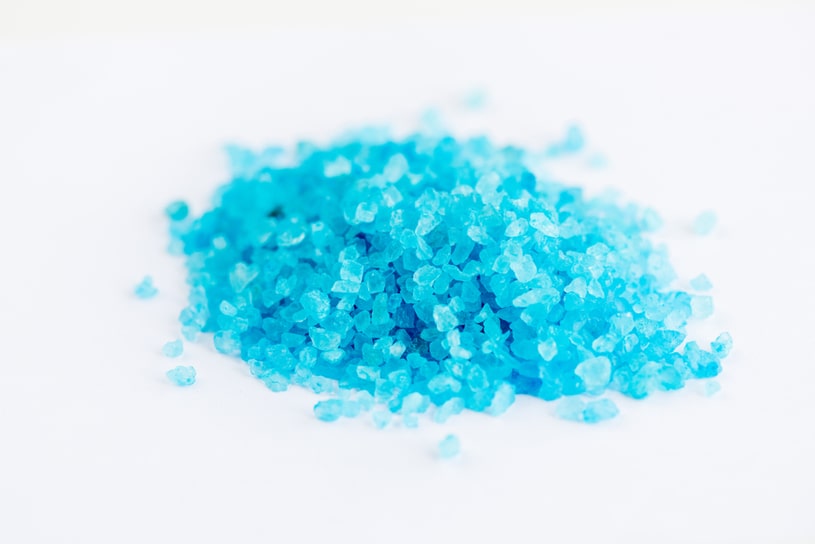Bath salt is a psychoactive designer drug with no medical use that can cause dangerous intoxication. This drug is made of synthetic chemicals that cause it to be one of the most addictive substances. The cases of bath salts abuse have risen in the past decade. The short and long-term effects of this drug can affect the body in various ways. This article will focus on bath salts’ side effects, symptoms of abuse, overdose, and more.
Table Of Contents:
Bath Salt Drugs: What Are They?
This drug is usually made in a lab and belongs to the group of synthetic cathinones. They come in various shapes, but two main forms are crystals and powder.
When it comes to all the identities synthetic cathinones have on the street, many of them are. In general, all synthetic cathinones are made in labs and include different compounds. This designer drug is much stronger than its origin, a natural stimulant from the African and Arabian khat plant. Here are some street names of this drug commonly used to refer to the same drug:
- MDVP
- Flakka
- Bloom
- Cloud nine drug
- Euphoria
- Vanilla sky
- Monkey dust
- Lunar wave
- Recharge
- Stardust
- Pyrovalerone
- White dove
- Tranquility
- Purple way
- Ocean snow
- Meow drug
Whatever these synthetic cathinones are called on the streets, some indications being bath salts high repeatedly over time, they can cause addiction.
The fact that the drug users have to seek professional medical treatment because of their symptoms show how serious the threat is. When it comes to different derivatives, such as bath salts vs. flakka, effects may vary from person to person. Still, they both can certainly cause drug-seeking behavior since users continue to abuse these drugs even though they know it is dangerous and that they are breaking the law. This behavior pattern is similar to other drugs, such as meth and cocaine.
Is This Substance Legal in The US?
According to the study about Synthetic cathinones, their legal status, and patterns of abuse, the Department of Justice placed methylenedioxypyrovalerone, mephedrone, and methylone in the Controlled Substances Act.
All drugs containing bath salts components are made illegal as well. Even though certain compounds are banned in some states, new compounds appear very often, and the authorities cannot keep track or work fast enough. If one uses a mixture that is not banned by law, one will not break the law. Therefore, even though there are many illegal bath salts, new types which are not banned yet are constantly being made. Even if the components have not yet been banned, this does not mean that this substance can be bought or consumed.
Signs and Symptoms of Bath Salts Abuse
Signs of bath salt drug abuse include several behavioral and physical changes in a person that can be noticeable to others.
Behavioral Signs of Addiction
Besides the common bath salt effects, certain types of behavior can help to detect if someone is having a bath salt addiction problem.
These behavior patterns include:
- stopping participation in family activities
- avoiding hanging out with friends
- changing life dynamics (noticeable at work or in school)
- a shift in focus
Some more specific signs that can be spotted in the behavior of a cloud nine drug abusers are:
- increased libido and sex drive
- paranoiac behavior
- hallucinations
- anxiety and panic attacks
- violent behavior
This substance is known to last up to eight hours with one dose, and bath salt stays in the system even longer, so abuse symptoms can be mainly visible in users’ behavior during the day.
Meanwhile, signs are different for everyone and depend on the method of ingestion, the amount is taken, and many other factors that are yet to be researched.
This makes the drug even more dangerous since users’ behavior can never be predicted, and it can get out of control quickly.
Physical Signs of The Drug Abuse
There are also physical effects of bath salts addiction besides the psychological ones. Abuse may lead to some health complications and severe conditions, including:
- numbing of muscles and tingling sensation
- chest pains
- heart attack
- seizures
- dizziness and blurred vision
- brainstem herniation
All of these are severe health risks of substance abuse, and if the user does not go through the detoxification step, long-term consequences may arise. They include kidney and liver damage, brain swelling, bath salts OD, and ultimately, death.
What are Bath Salt Side Effects?
There are chemical similarities between bath salts and cocaine or meth, so some of the side effects associated with those substances are mirrored in bath salt usage.
Physical Bath Salts Effects
Physical short-term side effects of using this drug include:
- Chest pains
- Appetite loss
- Nosebleeds
- Increased heart rate
- Headaches
- Increased body temperature
- Dizziness
- Brainstem herniation
- Seizures
- Blurry vision
- Nausea and vomiting
- The involuntary, rapid movement of the eyes
- Numbness
- Grinding of teeth
- Ringing in the ears
- Sexual dysfunction
- High fever
- Skin rash
- Excessive sweati
Mental Bath Salts Effects
Mental short-term side effects of the substance include:
- Dependency and addiction
- Insomnia
- Agitation
- Delirium (evolving from the initial false euphoria)
- Suicidal thoughts
- Confusion
- Panic attacks
- Hallucinations
- Psychosis
- Self-harm
- Nightmares
- Depression
- Violent behavior
- Anxiet
Short-Term Side Effects
The short term effects vary from mild to severe, with the mild reactions being the less dangerous reactions caused by using the substance. Additionally, the side effects can vary per individual.
Long Term Side Effects
Long-term effects have also been known to include severe behavioral disorders. It becomes tough to break free from usage because the substance is extremely addictive. Hence, the abusers constantly have to increase dosages to keep achieving the desired level of a high. At this stage, finding a program to help detox the drug from the system can be a tough task.
Common Long-Term Side Effects Include:
- Malnutrition
- Muscle damage
- Kidney failure
- Mental illness
- Narrowed blood vessels (vasoconstriction)
- Stroke
- Heart attack
- Cerebral edema
- Coma
- Memory loss
- Psychosis
- Addiction
- Liver failure
- Ulcer
- Bone damage
- Mood disorders
- Anorexia
- Erratic behavior
- Brain death
- Breakdown of skeletal muscle tissue
- Death
Additionally, users that ingest the substance by injection are faced with the likelihood of exhibiting these adverse reactions:
- Increased risk of blood-related illnesses such as hepatitis and HIV
- Vein blockage
- Gangrene
- Skin erosion
- Infection at the points of injection
- Abscesses
- Blood clots
The effects on the brain are the most commonly reported cases associated with long-term abuse.
The substance is so potent that a user with no prior history of any mental illness can easily get one using bath salts. People with a recessive genetic vulnerability to psychological illnesses will also see these vulnerabilities become dominant.
How Long Does It Stay In One’s System?
Unlike cocaine, amphetamine, or other illicit drugs, the drug’s half-life has not been extensively studied and could not yet be established. Although some health professionals indicate that cloud nine drug has a half-life of three to four hours, sometimes it can extend for up to 24 hours. The exact period that salt lasts in the body cannot be determined. It happens mostly due to the variety of formulations created for this designer drug.
Baths Salts And Drug Testing
Is there a drug test for it? Routine drug testing is not able to detect lunar waves. Thus, new modes of how to test it have been developed.
The drug tests examine specimens of urine, blood, hair, and saliva for the presence of cathinone.
Specific MDPV drug test examines the specimens for the MDPV component.
Some cloud nine drug formulations may contain synthetic cathinones like mephedrone and methylone. In which case, a mephedrone or methylone drug test will be required to detect possible abuse of cloud nine drug.
How Long Can The Drug Be Found In Urine, Blood, Hair, And Saliva?
An MDPV drug testing will detect lunar wave in the system depending on the specimen being tested. In general, testing for this substance in urine will usually show a positive result if the test is taken for up to 72 hours following the last intake and up to 90 days after intake if hair analysis is conducted.
How Long Can The Drug Be Found In Urine?
This test provides results with relatively higher reliability than a saliva test and a quicker turnaround time than a blood test. However, the window period for detecting the presence of cloud nine drug in the urine is highly variable. It may last from a few hours to a few days.
How Long Can The Drug Be Found In Blood?
This is the most invasive type of testing. Turnaround time for results may take anywhere from several days up to weeks and, therefore, is best reserved for confirmatory testing of positive results.
How Long Can The Drug Be Found In Hair?
Cathinones may be deposited in hair strands for up to 3 months from the last intake. Cathinones in hair may be undetected until a few weeks following intake of the lunar wave.
How Long Can The Drug Be Found In Saliva?
Test kits used to detect methamphetamine in the system have been demonstrated to react with cloud nine drug.
However, these testing kits react inconsistently with cathinones, and the window period for testing is up to a few hours after intake only.
Bath Salts Overdose
When a person overdoses on bath salt, there is a possibility of becoming a bath salts zombie. This condition presents with violent behavior, delirium, and critical self-harm. Salt overdose can be life-threatening and end up with the user’s death, according to the Q J Med Journal.
Poison Control Center of Michigan reports that 50% of the people that used synthetic cathinones experienced various side effects, and a high amount of bath salt overdoses was noticed among them. So, why is there such a high amount of overdoses?
Drug Interactions
The presence of bath salt and alcohol in an individual’s system makes the likelihood of bath salt overdose more likely. Alcohol is a frequent culprit in cases of overdose. Some people overdose accidentally because they had alcohol or another drug in their system before taking this drug.
The interference of certain drugs with neurotransmitters and their ability to cross the blood-brain barrier can severely affect the body even without taking a lethal dose of the salt.
Misuse of Bath Salts in Parties
A study discovered that synthetic cathinones were found to wreak more havoc on people who are in stuffy places with many people. When people use this drug at parties and rave concerts, a salt overdose is more likely to happen.
Health Conditions
Chronic pain is one of the most under-recognized causes of OD. Desperacy pushes people to use illicit drugs when undergoing pain continually.
Regrettably, such individuals may end up with overdose, as it happens more frequently with individuals who are struggling with depression. This condition can make people OD on synthetic cathinones due to its low price and availability.
Signs And Symptoms Of Overdose
The overdose symptoms can lead to severe health damage if not noticed and treated in time. This is why one has to be observant when some of these symptoms are being manifested in people.
Some of the symptoms of the drug overdose outlined by a medical review include:
Insomnia
Patients who overdosed on synthetic cathinones are restless during the day and struggle with sleeplessness. The challenge of insomnia doesn’t end with finding sleep, as it extends to the difficulty of staying awake. One of the first signs of bath salt overdose is insomnia.
Spasms
Synthetic cathinones overdose can amount to the presentation of uncontrollable spasms. When people convulse, they may injure themselves accidentally, which is why the trigger for the seizure needs to be identified. If synthetic cathinones are identified as that trigger, then specific management needs to be done.
Panic Attacks
Anxiety disorders may precipitate the need to turn to calming drugs, and this drug may just have been available. People have an overwhelming worry that’s uncontrollable while using illicit drugs such as synthetic cathinones. This occurs especially when such people have lethal doses of synthetic cathinones in their system.
Heart Attack And Tachycardia
Initially, when the dose of bath salts or flakka has been exceeded, the likelihood of one feeling one’s heartbeat is common. Still, when the heartbeat gets rapid, a heart attack may be imminent, and the heart of a person that has just OD may stop working totally.
Stroke
The brain requires a constant blood supply, unlike other organs in the body. If there’s blood cessation to the brain for as little as 5 seconds, one loses consciousness. However, the likelihood of such an occurrence increases with the presence of a lethal dosage of synthetic cathinones.
Other Symptoms of Salt Overdose May Include The Following:
- Chest pain
- Hypertension
- Hyperthermia
- Hyponatremia
- Inflammation within the muscular fascia compartments
- Nausea
- Rhabdomyolysis
- Vomiting
In rats, doses above 10mg/kg showed severe depletion of brain serotonin. Also, just a mere 0.2mg/kg showcased erratic drug abuse. However, further studies on the lethal dose for humans is still unknown.
Response to Bath Salts Overdose
To give first-aid to a person that overdosed on synthetic cathinones, one may need to do the following to prevent death from the drug:
- The quantity of the substance taken
- Any other substances that were taken with this drug
- The mental health of the individual
- The age, weight, and height of the OD patient
Then call for emergency services and monitor their condition before the arrival of caregivers, and give emergency responders all the necessary information mentioned above.
Treating Bath Salts Overdose in a Medical Facility
The first-line treatment is usually benzodiazepines. Lorazepam is an example of this class of drugs, and they are used to control agitation, restlessness, and aggressiveness of the patient.
If there is a case of such side effects as hyperthermia, the patient must be cooled pharmacologically and physically to ensure a rapid fall in temperature.
Other drugs administered to calm patients with overdose are as follows:
- Etomidate
- Midazolam
- Succinylcholine
When the effects of synthetic cathinones are stopped, the user is likely to experience withdrawal symptoms. They may be severe, and it may be challenging to manage them at home. This is why the addicts should enroll in a rehabilitation program for lasting recovery and therapeutic support. Detox and recovery are more successful with the help of healthcare professionals at the rehabs and detox centers.
Treating Bath Salt Abuse
Treatment for abuse of bath salts exists. It mainly consists of behavioral therapy, which aims to inform users about the consequences of addiction, motivate them to stay clean and provide support during the process. The addiction treatment should be tailored to the individual to be effective, but another good option is to join a rehabilitation program.
There is no medication for treating addiction to synthetic cathinones, so therapy and rehabilitation are the best options.
Recovery from Synthetic Cathinones
When it comes to recovering from bath salts addiction, the person can recover completely if it is started on time. However, the problem is not in recovering physically and being healthy again. It is rather challenging to overcome the physiological consequences that addiction leads to, especially if the individual suffered from traumatic hallucinations and suffers from a poor mental state in general.
Bath salts withdrawal is an essential part of the addiction treatment, and then a patient is getting support through a recovery program. The withdrawal process may be followed by insomnia, anxiety, depression, and decreased concentration and ability to think and focus. The intensity of symptoms will vary depending on the length and method of use and the user’s mental state.
When a symptom of bath salt use or abuse is noticed in an individual, appropriate medical attention must be sought immediately. In fact, if there is evidence of first use, there must be an intervention and detoxification even before any symptoms start to show. It is better not to experiment with this particular designer drug, stay healthy, and not get punished by law.
Page Sources
- Fass JA, Fass AD, Garcia AS, Synthetic cathinones (bath salts): legal status and patterns of abuse, https://www.ncbi.nlm.nih.gov/pubmed/22388331/
- Synthetic Cathinones (“Bath Salts”), https://www.drugabuse.gov/publications/drugfacts/synthetic-cathinones-bath-salts
- Jennifer A. Gershman and Andrea D. Fass, Synthetic Cathinones (‘Bath Salts’) – Legal and Health Care Challenges, 2012, https://www.ncbi.nlm.nih.gov/pmc/articles/PMC3474442/
- National Institute on Drug Abuse for Teens, Bath Salts, Revised February 2019, https://teens.drugabuse.gov/drug-facts/bath-salts
- Patrick S. Johnson and Matthew W. Johnson, Investigation of “Bath Salts” Use Patterns Within an Online Sample of Users in the United States, November-December, 2014, https://www.ncbi.nlm.nih.gov/pmc/articles/PMC4266324/
- Gregory C. Hadlock, Katy M. Webb, Lisa M. McFadden, Pei Wen Chu, Jonathan D. Ellis, Scott C. Allen, David M. Andrenyak, Paula L. Vieira-Brock, Christopher L. German, Kevin M. Conrad, Amanda J. Hoonakker, James W. Gibb, Diana G. Wilkins, Glen R. Hanson, and Annette E. Fleckenstein, 4-Methylmethcathinone (Mephedrone): Neuropharmacological Effects of a Designer Stimulant of Abuse, https://www.ncbi.nlm.nih.gov/pmc/articles/PMC3200001/
- S Creagh, D Warden, MA Latif, A Paydar, The New Classes of Synthetic Illicit Drugs Can Significantly Harm the Brain: A Neuro Imaging Perspective with Full Review of MRI Findings, https://www.ncbi.nlm.nih.gov/pmc/articles/PMC6048967/
- Centers for Disease Control and Prevention (CDC), Emergency department visits after use of a drug sold as “bath salts”–Michigan, November 13, 2010-March 31, 2011, https://www.ncbi.nlm.nih.gov/pubmed/21597456
- JOHN M. STOGNER & BRYAN LEE MILLER, Investigating the ‘bath salt’ panic: The rarity of synthetic cathinone use among students in the United States, https://onlinelibrary.wiley.com/doi/pdf/10.1111/dar.12055
More About Illicit Drugs:

 Authored by
Authored by  Reviewed by
Reviewed by 





